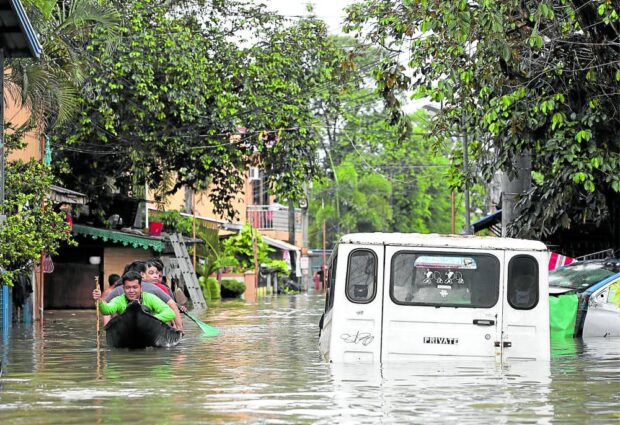Motorists endure gridlock as floods hit parts of NLEx

VILLAGE RIDE Floodwaters rise to at least 1.52 meters (5 feet) in the inner roads of Barangay Frances in Calumpit town, Bulacan province, on Monday, forcing residents to take a boat. Heavy rains in the past few days also flooded sections of the North Luzon Expressway in Bulacan and Pampanga on Monday and Tuesday. —LYN RILLON
CITY OF SAN FERNANDO—Portions of the North Luzon Expressway (NLEx) have been flooded for the second day on Tuesday, causing traffic to crawl at a snail’s pace, creating long queues of vehicles and at times stretching to 10 kilometers on the northbound lanes.
According to an NLEx advisory at 3 p.m. Tuesday, traffic toward the north before the Pulilan interchange in Bulacan to the Tulaoc Bridge in San Simon, Pampanga province, was heavy, with approximately 5 to 10 kilometers per hour running speed due to flooding caused by the swollen Pampanga River.
It reported the same situation on the southbound stretch of San Fernando to Tulaoc Bridge, adding that floods were due to the river overflow and resulting floods since Monday.
The Pampanga River, originating in the Caraballo Mountains, drains 30 rivers in Central Luzon to Manila Bay.
In its Tuesday advisory, the Pampanga River Flood Forecasting and Warning Center based here said water levels in the Arayat, Candaba and Apalit (Pampanga) stations have surpassed critical levels as water from Nueva Ecija province flowed to the mouth of the delta, where the coastal towns of Pampanga are located. Pampanga was placed under a state of calamity on Monday due to the widespread flooding.
Netizens like Jason Quejado Zarate posted footage of bumper-to-bumper vehicles stretching for several kilometers. Another complained that NLEx Corp. increased the toll prior to the flooding there.
In a social media post, another motorist, who was stuck for almost an hour, called himself a “victim of this poor civil engineering design for its lack of hydrological and flood plain modeling.”
Others, like Ellen Inocencio, 30, said she was trapped in the gridlock for seven hours while going home to Zambales province on Monday night.
“The bus left the terminal in Manila at 6:30 a.m. on Monday, and I only reached Olongapo City by 11:45 p.m. that day. I was home by 1 a.m.,” Inocencio told the Inquirer, adding that it would normally take her between three and four hours of travel from Manila to Zambales on an ordinary day.
Submerged in flood
According to the regional disaster risk reduction and management council, at least 438 areas in the entire Central Luzon were submerged in floodwater as of Monday due to the incessant rains spawned by the southwest monsoon, which was previously enhanced by Typhoon “Egay” (international name: Doksuri), which was already out of the country, and by Typhoon “Falcon” (Khanun).
In its weather bulletin on Tuesday morning, the Philippine Atmospheric, Geophysical and Astronomical Services Administration said Falcon was spotted 925 km east northeast of extreme northern Luzon and packed maximum sustained winds of 175 kph near the center with gustiness of up to 215 kph.
At the height of the onslaught of Egay, at least 438 areas in Central Luzon were submerged in floodwater that rose to 1.82 meters (6 feet) deep in some portions of Bulacan province, according to the regional disaster risk reduction and management council (RDRRMC). As of Monday, more than 8,800 families, or 32,400 people, in Central Luzon remained in various evacuation centers, RDRRMC data showed.
—WITH A REPORT FROM JOANNA ROSE AGLIBOT INQ
READ:
Pagasa warns residents near Angat River, Ipo Dam: Brace for floods
Cayetano, Villanueva, Legarda raise flood concerns over unfinished DPWH projects